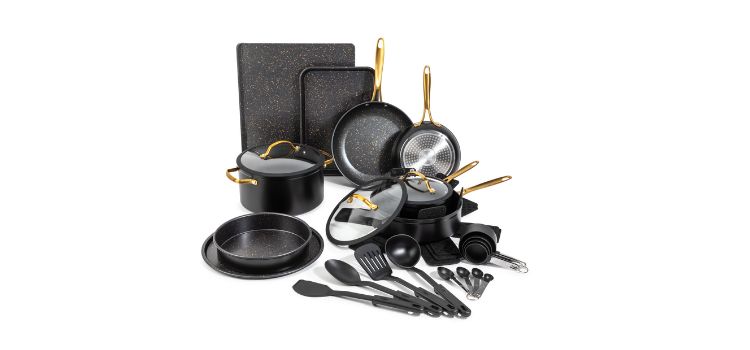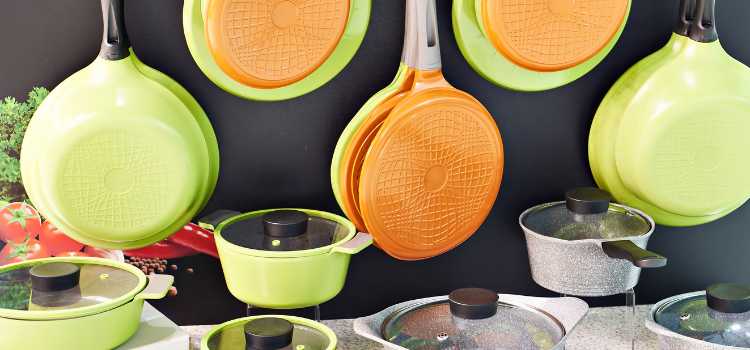As an Amazon Associate, I earn from qualifying purchases

In recent years, ceramic and titanium cookware have gained significant popularity among home cooks and professional chefs alike. Known for their modern aesthetics and promising performance, these materials are often marketed as safer alternatives to traditional non-stick options.
But just how safe are they? In this article, we will explore the safety of ceramic and titanium cookware, delving into their benefits, potential concerns, and how they compare to other cookware types.
Understanding Ceramic and Titanium Cookware
Ceramic and titanium cookware are often lauded for their unique properties and construction. Ceramic cookware is typically made from a metal base coated with a layer of ceramic, providing a non-stick surface that is free from synthetic chemicals. This ceramic coating is derived from natural substances, making it an attractive option for health-conscious consumers.
Titanium cookware, on the other hand, involves a base material, such as aluminum or stainless steel, coated or infused with titanium. This combination results in a lightweight but incredibly durable product. Titanium is renowned for its strength and resistance to corrosion, making it a popular choice for cookware manufacturers.
Benefits of Ceramic and Titanium Cookware
Ceramic Cookware:
- Non-Stick Nature: Offers a natural non-stick surface without harmful chemicals like PTFE or PFOA.
- Healthier Cooking: Requires less oil, leading to healthier meal options.
- Environmentally Friendly: Considered more eco-friendly and non-toxic compared to traditional options.
Titanium Cookware:
- Heat Distribution: Known for excellent heat distribution, heating quickly and evenly.
- Durable: Resists scratches and dents, making it ideal for daily use.
- Prevents Hot Spots: Reduces the risk of burning food due to its even heating properties.
- Ease of Cleaning: Both ceramic and titanium cookware are easy to clean, typically needing just a wipe with a damp cloth or sponge.
- Stylish Designs: Available in various appealing designs and colors, enhancing the aesthetic of any kitchen.
Safety Concerns and Considerations
Despite their benefits, there are safety concerns associated with ceramic and titanium cookware. With ceramic cookware, the main issue lies in the coating itself. Over time, the ceramic layer can wear down or chip, potentially leading to exposure of the underlying metal. When this happens, the cookware’s non-stick properties diminish, and there may be concerns about metal leaching, especially if the base is aluminum.
Titanium cookware is generally considered safe, as titanium is non-toxic and biocompatible. However, not all titanium cookware is created equal. It’s important to ensure that the product is high-quality and doesn’t contain harmful additives. Some titanium cookware may still use non-stick coatings that could pose safety concerns if overheated.
Consumers should also be mindful of the manufacturing processes and materials used, as lower-quality products may not adhere to the same safety standards as reputable brands.
Comparison with Other Cookware Types

When comparing ceramic and titanium cookware to other types, such as stainless steel or traditional non-stick, several factors come into play. Stainless steel is highly durable and non-reactive, making it a safe choice for all types of cooking. However, it lacks the non-stick properties of ceramic and may require more oil or butter for cooking.
Traditional non-stick cookware, often made with PTFE, offers excellent ease of use but has come under scrutiny for potential health risks when overheated. Ceramic provides a similar non-stick experience without these chemicals, making it a safer alternative.
Titanium cookware, with its lightweight and robust nature, offers a distinct advantage over heavier cast iron or stainless steel in terms of ease of handling and maintenance. However, it often costs more, which is a consideration for budget-conscious consumers.
Consumer Reviews and Expert Opinions
Consumer feedback on ceramic and titanium cookware is generally positive, with many users praising the non-stick capabilities and ease of cleaning. Ceramic cookware is often favored for its vibrant colors and contemporary look, while titanium is appreciated for its resilience and quick heating.
Experts tend to agree that both ceramic and titanium cookware offer safer alternatives to traditional non-stick options. However, they emphasize the importance of quality and caution against using cookware with damaged surfaces. Experts also recommend adhering to manufacturer guidelines to ensure longevity and safety.
Tips for Safe Use and Maintenance
To maximize the safety and lifespan of ceramic and titanium cookware, consider the following tips:
- Use Low to Medium Heat: Both ceramic and titanium cookware perform well at lower temperatures. Avoid using high heat to prevent damage to coatings and ensure even cooking.
- Proper Utensils: Use wooden, silicone, or plastic utensils to avoid scratching the surface, especially with ceramic coatings.
- Gentle Cleaning: Hand wash with mild soap and a soft sponge to maintain the integrity of the coating. Avoid abrasive cleaners or steel wool.
- Avoid Temperature Shock: Do not expose the cookware to sudden temperature changes, such as moving from a hot stovetop to cold water, which can cause cracking or warping.
- Inspect Regularly: Regularly check for chips or wear in the coating. Replace cookware if the surface is compromised to prevent potential safety risks.
Conclusion
Ceramic and titanium cookware offer promising benefits in terms of safety, performance, and aesthetics. While they are generally considered safer alternatives to traditional non-stick options, consumers should remain vigilant about their condition and quality.
By following proper usage and maintenance guidelines, you can safely enjoy the advantages these modern materials bring to your cooking experience. Ultimately, making informed decisions based on your personal cooking needs and safety preferences will ensure that your cookware choices align with your lifestyle and health priorities.
FAQ
What is the safest cookware for your health?
The safest cookware for your health typically includes stainless steel, cast iron, and glass. These materials are non-reactive and do not leach harmful chemicals into food. Additionally, well-made ceramic and titanium cookware are considered safe options as they are free from toxic coatings found in some non-stick variants.
What are the disadvantages of titanium cookware?
While titanium cookware is lightweight and durable, it can be expensive compared to other options. The non-stick properties may diminish over time if not properly maintained, and the cookware may require specific care to avoid damaging the coating. Additionally, not all titanium cookware is pure titanium, which may affect performance.
What is ceramic titanium coating?
Ceramic titanium coating is a combination used in cookware that involves infusing or coating a base metal with titanium and ceramic. This blend enhances durability and non-stick properties, offering a safer cooking surface free from harmful chemicals like PTFE. It provides efficient heat distribution and is easy to clean.
As an Amazon Associate, I earn from qualifying purchases